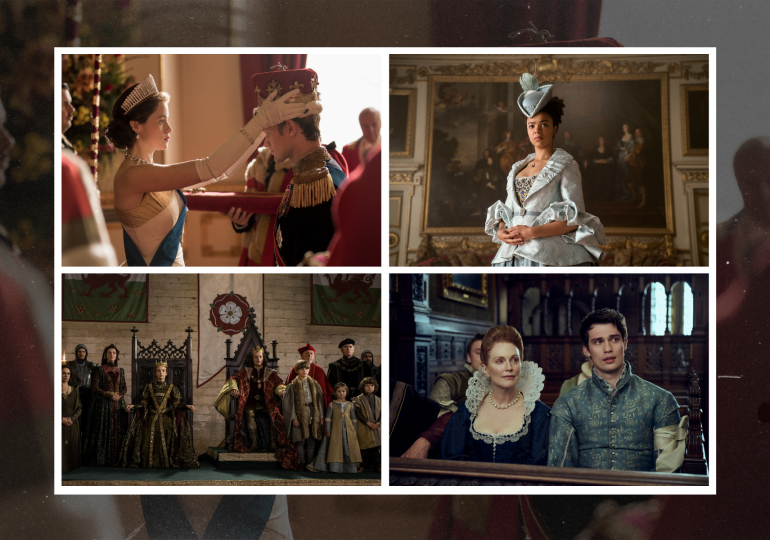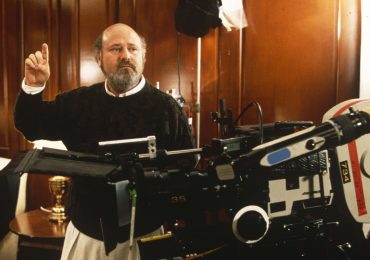History tends to be naughtier than the standard textbook lets on, and television has noticed. From The Tudors to The Crown, the past few decades have brought an endless stream of period dramas that promise to reveal what was really happening in the courts—and particularly the bed chambers—of English and British monarchs dating back to the Middle Ages. If you plotted these series on a grid, one axis would range from highbrow to lowbrow and the other, from prim to filthy. Each title’s position would amount to a sort of overall salaciousness quotient, with the most educational of the bunch in one corner and the sudsiest in the opposite corner.
[time-brightcove not-tgx=”true”]
What follows, albeit in list form rather than on a two-dimensional grid, is a ranking of TV dramas about British royals from least to most salacious, taking into account both luridness and seriousness. The list is compiled in honor of Starz’s brazenly scandalous, wickedly fun new series, Mary & George, starring Julianne Moore as a minor 17th century aristocrat and Nicholas Galitzine as the devastatingly handsome son she’s scheming to get into King James I’s bed, though there’s no doubt there will be opportunity to add more entries in the future. Six centuries’ worth of Elizabeths and Annes, Henrys and Thomases, await your judgment below.
Victoria (PBS, 2016-2019)
When we meet the teenager soon to be crowned Queen Victoria (Jenna Coleman), in this ITV import that aired under the Masterpiece banner in the U.S., she still keeps a beloved doll by her side and seems unaware that sex is a prerequisite for pregnancy. So it makes sense that Victoria, which traces her first couple of decades on the throne, feels more like a fairy tale than a soap opera. Innocent though she is, Coleman’s Victoria is a willful young woman determined to prove herself an effective monarch, even as jealous relatives and ambitious politicians plot to sideline her. While there’s plenty of palace gossip—infidelity, same-sex affairs, bitter rivalries—the series is (fully clothed wedding-night love scene aside) about as chaste as it gets.
Wolf Hall (PBS, 2015)
Wolf Hall, which tracks the rise and fall of Anne Boleyn through the machinations of wily statesman Thomas Cromwell, certainly has a more worldly perspective than Victoria. Cromwell, played by the great Mark Rylance, is a master of realpolitik, capable of manipulating and emboldening Henry VIII (Damian Lewis) to murderous effect. So there’s quite a bit of violence and death in the six-part series, though not much in the way of sex. But it’s also (sorry, The Crown) the best royal drama of our time, adapted from two Booker-winning novels by the late doyenne of historical fiction Hilary Mantel and boasting many BAFTAs, Globes, and Emmy nominations. A sequel, currently in the works, that wraps up Cromwell’s story, Wolf Hall: The Mirror and the Light, is sure to deliver more eloquently scripted, brilliantly acted court intrigue from the high-minded folks at BBC Two.
The Crown (Netflix, 2016-2023)
In part because contemporary royals have less real power and must show more restraint than their pre-tabloid ancestors, and in part because creator Peter Morgan chose to be relatively polite to his subjects, many of whom are still alive, The Crown’s portrait of Queen Elizabeth II and her family could feel pretty tame. Sure, we hear about quite a bit of infidelity. Princess Margaret (Vanessa Kirby) has her naughty photoshoot with Lord Snowdon (Matthew Goode). Charles (Dominic West) and Camilla’s (Olivia Williams) Tampongate phone-sex recordings are reenacted in lurid detail. But you’d be hard pressed to find R-rated sex scenes, much less the kind of violence a Henry VIII unleashed within his palace walls as well as beyond them.
Elizabeth I (HBO, 2005)
There have been two ruling British monarchs named Elizabeth, and Helen Mirren played both of them in the mid-aughts—the second in Morgan and his Crown collaborator Stephen Frears’ film The Queen, and the first in this two-parter that originally aired on Channel 4 in the UK. Opening in 1579, when Elizabeth was in her mid-40s and searching for a husband in a last-ditch effort to produce an heir, it pays no lip service to her Virgin Queen nickname. Mirren’s libidinous sovereign consorts with Jeremy Irons’ silver-fox Earl of Leicester—until she learns he’s secretly married and orders him to get out of her sight. A decade later, in Part 2, she obsesses over a new favorite: Leicester’s stepson, the Earl of Essex (Hugh Dancy), who’s a good 32 years her junior. There’s lots of substantive history here, surrounding a Protestant woman’s struggle to retain her throne as Catholic leaders at home and abroad plotted her overthrow. And it should go without saying that Mirren is magnificent. Elizabeth I practically swept the Emmys. But between the emphasis on torrid love affairs and a good deal of gorily rendered, period-appropriate torture, E. Tudor edges out E. Windsor on the salaciousness scale.
The White Queen, The White Princess, and The Spanish Princess (Starz, 2013-2020)
I’m grouping these three Starz titles together because they follow three consecutive generations of English queens, beginning during the War of the Roses, and are all adapted from the prolific author Philippa Gregory’s Plantagenet and Tudor novels. The first and most romantic show in the trilogy, The White Queen, casts Rebecca Ferguson as Elizabeth Woodville, the young Lancastrian widow who wins the heart of the Yorkist monarch Edward IV. The White Princess revolves around Woodville’s daughter, also named Elizabeth, who is played, in the franchise’s standout performance, by a steely Jodie Comer. And The Spanish Princess sticks close to the fish-out-of-water perspective of Catherine of Aragon (Charlotte Hope), who’s transported to a chilly new land to marry then-Prince of Wales Arthur and, later, his younger brother Henry VIII.
What the series share is a tone that splits the difference between prestige costume drama, high melodrama, and fairy tale (the Elizabeths come from a family that practices magic). Neither prudish nor, for the most part, smutty, the love scenes come straight out of middle-of-the-road romance novels. War feels tragic more than brutal. Yet, as in Victoria, the focus of these shows is, sometimes anachronistically, strong women forging legacies within a patriarchal culture.
Queen Charlotte: A Bridgerton Story (Netflix, 2023)
Shonda Rhimes is no longer beholden to the prim Standards and Practices of broadcast TV, and her Netflix output takes full advantage of that newfound freedom. So, like the hit Shondaland Regency romance Bridgerton, from which it was spun off, Queen Charlotte can get pretty steamy. But unlike the fictional Bridgerton family, Charlotte (played by India Amarteifio as a young woman and Golda Rosheuvel as a mature queen) is based on the real Princess Sophie Charlotte of Mecklenburg-Strelitz, who married King George III in 1761 and only later became aware of his so-called madness. While the series treats George’s (Corey Mylchreest) mental illness with all the sensitivity it deserves, this is largely a story about sexual awakening—not just that of a new wife, but also, in flash-forwards to the 19th century, that of a middle-aged widow who, as she puts it, suddenly finds her “garden in bloom” after many dry years.
Reign (The CW, 2013-2017)
When this four-season teen drama extremely loosely based on Mary, Queen of Scots’ betrothal to Francis II of France premiered in 2013, it broke the brain of The Hollywood Reporter’s Tim Goodman. “The CW is ruining America,” he complained. “It is dumbing down an increasingly dumb country.” Examples cited in his indictment: a (relatively tame) masturbation scene, an obligatory YA love triangle, and a ridiculously hot Nostradamus. In truth, the show wasn’t exactly the nadir of Western civilization. It was just a deeply anachronistic excuse to dress Teen Wolf alum Adelaide Kane in vaguely 16th-century (via Coachella and ’90s prom) gowns, surround her with giggly ladies in waiting, and send the whole crew on a series of coming-of-age misadventures. Though far less explicit than Queen Charlotte, Reign is also significantly sillier; hence its ranking above some of the many royal dramas that show bare butts.
Mary & George (Starz, 2024—)
When George arrives at a venerable institution of higher learning in France, in Mary & George’s premiere, another student walks him to his room, through an ornate parlor where a dozen or so young men and women are engaged in an orgy. “Did you take me there on purpose?” George demands. “To humiliate me?” His host assures him that, no, there are only two paths to his chamber—and pushes open a door to reveal more people having sex along the second route. The scene sets the mood for seven episodes of saucy gossip, wanton violence, and all manner of pansexual debauchery. There’s witchcraft and poisoned prunes. Queen Elizabeth I is mocked as “some magic hymen savior of all mankind.” Sir Francis Bacon describes himself as “a very good buggerer.” And once George schemes his way into the monarch’s bedroom, King James ends up in some rather compromising positions. It doesn’t get much more salacious than this.
The Tudors (Showtime, 2007-2010)
“Now, I can go play,” announces Jonathan Rhys Meyers’ louche Henry VIII in this notoriously racy drama’s earliest scenes. He has just responded to the assassination of an English ambassador with the decision to declare war on France, and now it’s time for him to, quite nakedly, chase a mistress around the bedpost. As that introduction suggests, while The Tudors covers many of the same characters and events as Wolf Hall, the two shows couldn’t be more different. Whether he’s seducing a new plaything (or a future wife) or wrestling his Gallic counterpart, King Francis I, this Henry is ruled by vanity and avarice. Also: he is improbably hot, as are the dozens of other actors who disrobe over the course of the series’ 38 episodes.
Played with Meyers’ signature sensuous brattiness, the sovereign, surrounded by sycophants, allows his ego to drive every choice he makes on the throne—poisoning not just his court, but also his country and Europe at large. Mary & George certainly outpaces The Tudors in varieties of deviance depicted. Yet no other TV series to date has painted such a deliciously nasty, nihilistic portrait of British royalty and the gratuitous misery in which a narcissistic king revels.
Leave a comment








